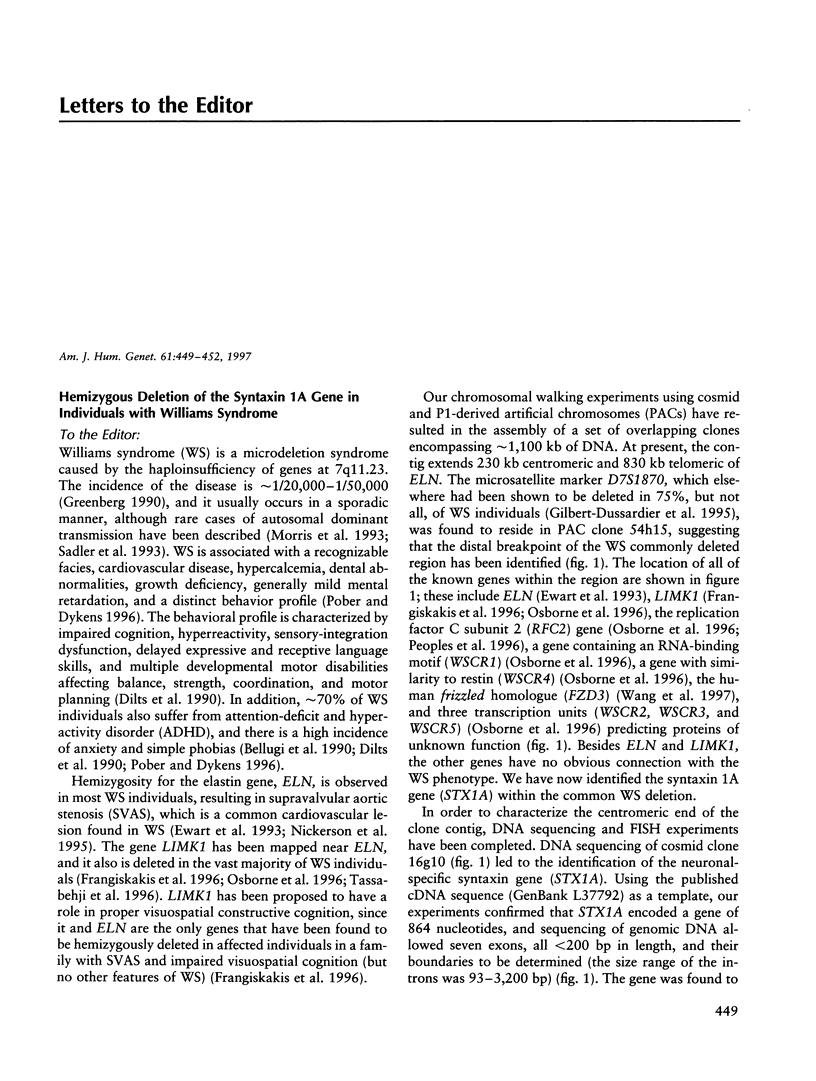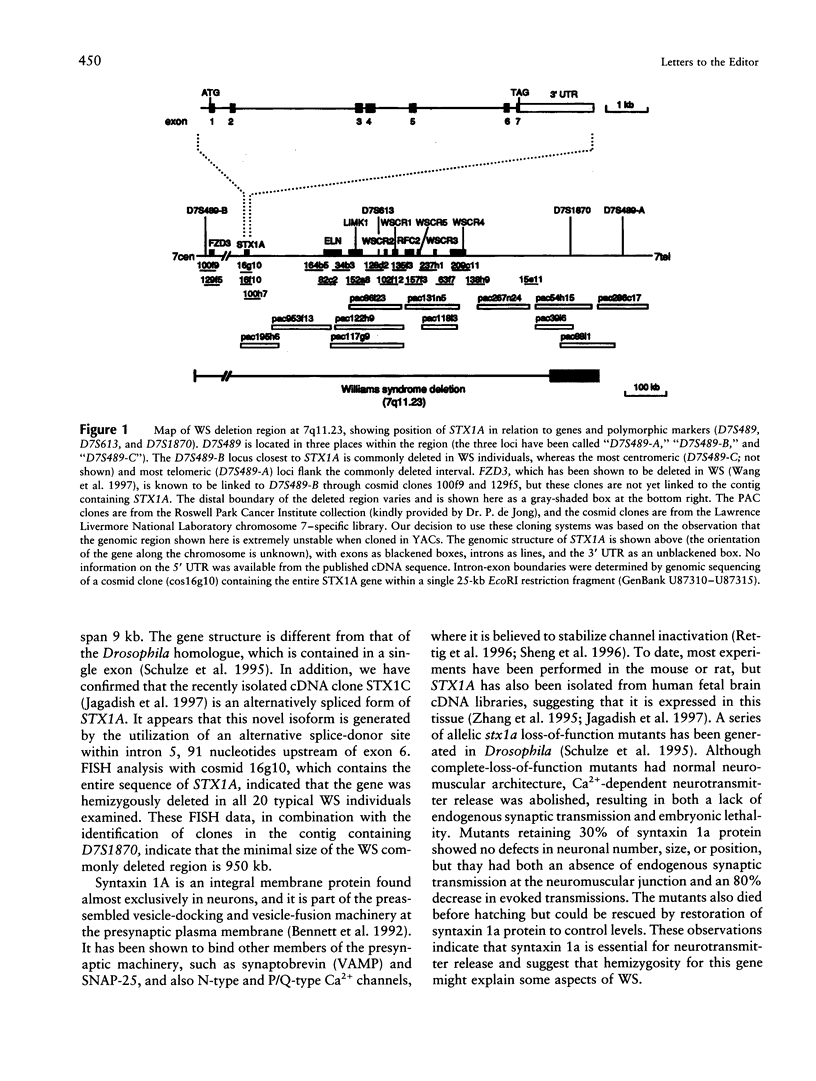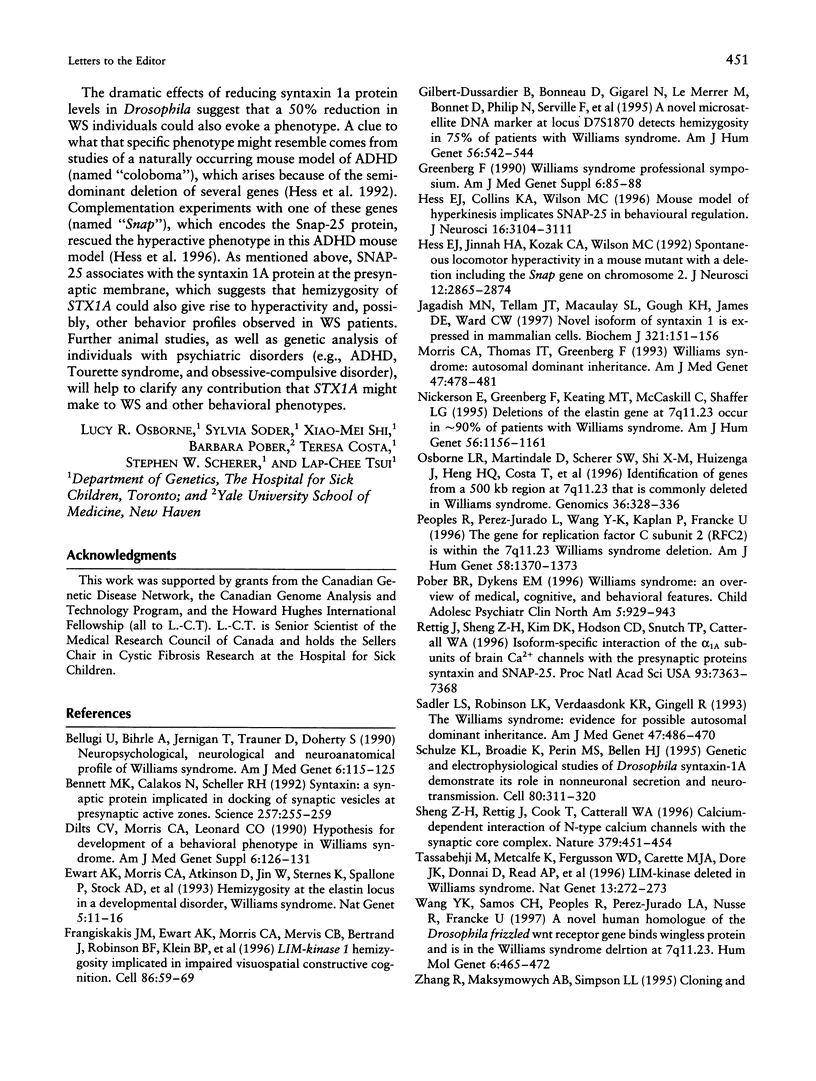Full text
PDF



Selected References
These references are in PubMed. This may not be the complete list of references from this article.
- Bellugi U., Bihrle A., Jernigan T., Trauner D., Doherty S. Neuropsychological, neurological, and neuroanatomical profile of Williams syndrome. Am J Med Genet Suppl. 1990;6:115–125. doi: 10.1002/ajmg.1320370621. [DOI] [PubMed] [Google Scholar]
- Bennett M. K., Calakos N., Scheller R. H. Syntaxin: a synaptic protein implicated in docking of synaptic vesicles at presynaptic active zones. Science. 1992 Jul 10;257(5067):255–259. doi: 10.1126/science.1321498. [DOI] [PubMed] [Google Scholar]
- Dilts C. V., Morris C. A., Leonard C. O. Hypothesis for development of a behavioral phenotype in Williams syndrome. Am J Med Genet Suppl. 1990;6:126–131. doi: 10.1002/ajmg.1320370622. [DOI] [PubMed] [Google Scholar]
- Ewart A. K., Morris C. A., Atkinson D., Jin W., Sternes K., Spallone P., Stock A. D., Leppert M., Keating M. T. Hemizygosity at the elastin locus in a developmental disorder, Williams syndrome. Nat Genet. 1993 Sep;5(1):11–16. doi: 10.1038/ng0993-11. [DOI] [PubMed] [Google Scholar]
- Frangiskakis J. M., Ewart A. K., Morris C. A., Mervis C. B., Bertrand J., Robinson B. F., Klein B. P., Ensing G. J., Everett L. A., Green E. D. LIM-kinase1 hemizygosity implicated in impaired visuospatial constructive cognition. Cell. 1996 Jul 12;86(1):59–69. doi: 10.1016/s0092-8674(00)80077-x. [DOI] [PubMed] [Google Scholar]
- Gilbert-Dussardier B., Bonneau D., Gigarel N., Le Merrer M., Bonnet D., Philip N., Serville F., Verloes A., Rossi A., Aymé S. A novel microsatellite DNA marker at locus D7S1870 detects hemizygosity in 75% of patients with Williams syndrome. Am J Hum Genet. 1995 Feb;56(2):542–544. [PMC free article] [PubMed] [Google Scholar]
- Hess E. J., Collins K. A., Wilson M. C. Mouse model of hyperkinesis implicates SNAP-25 in behavioral regulation. J Neurosci. 1996 May 1;16(9):3104–3111. doi: 10.1523/JNEUROSCI.16-09-03104.1996. [DOI] [PMC free article] [PubMed] [Google Scholar]
- Hess E. J., Jinnah H. A., Kozak C. A., Wilson M. C. Spontaneous locomotor hyperactivity in a mouse mutant with a deletion including the Snap gene on chromosome 2. J Neurosci. 1992 Jul;12(7):2865–2874. doi: 10.1523/JNEUROSCI.12-07-02865.1992. [DOI] [PMC free article] [PubMed] [Google Scholar]
- Jagadish M. N., Tellam J. T., Macaulay S. L., Gough K. H., James D. E., Ward C. W. Novel isoform of syntaxin 1 is expressed in mammalian cells. Biochem J. 1997 Jan 1;321(Pt 1):151–156. doi: 10.1042/bj3210151. [DOI] [PMC free article] [PubMed] [Google Scholar]
- Morris C. A., Thomas I. T., Greenberg F. Williams syndrome: autosomal dominant inheritance. Am J Med Genet. 1993 Sep 15;47(4):478–481. doi: 10.1002/ajmg.1320470409. [DOI] [PubMed] [Google Scholar]
- Nickerson E., Greenberg F., Keating M. T., McCaskill C., Shaffer L. G. Deletions of the elastin gene at 7q11.23 occur in approximately 90% of patients with Williams syndrome. Am J Hum Genet. 1995 May;56(5):1156–1161. [PMC free article] [PubMed] [Google Scholar]
- Osborne L. R., Martindale D., Scherer S. W., Shi X. M., Huizenga J., Heng H. H., Costa T., Pober B., Lew L., Brinkman J. Identification of genes from a 500-kb region at 7q11.23 that is commonly deleted in Williams syndrome patients. Genomics. 1996 Sep 1;36(2):328–336. doi: 10.1006/geno.1996.0469. [DOI] [PubMed] [Google Scholar]
- Peoples R., Perez-Jurado L., Wang Y. K., Kaplan P., Francke U. The gene for replication factor C subunit 2 (RFC2) is within the 7q11.23 Williams syndrome deletion. Am J Hum Genet. 1996 Jun;58(6):1370–1373. [PMC free article] [PubMed] [Google Scholar]
- Rettig J., Sheng Z. H., Kim D. K., Hodson C. D., Snutch T. P., Catterall W. A. Isoform-specific interaction of the alpha1A subunits of brain Ca2+ channels with the presynaptic proteins syntaxin and SNAP-25. Proc Natl Acad Sci U S A. 1996 Jul 9;93(14):7363–7368. doi: 10.1073/pnas.93.14.7363. [DOI] [PMC free article] [PubMed] [Google Scholar]
- Sadler L. S., Robinson L. K., Verdaasdonk K. R., Gingell R. The Williams syndrome: evidence for possible autosomal dominant inheritance. Am J Med Genet. 1993 Sep 15;47(4):468–470. doi: 10.1002/ajmg.1320470406. [DOI] [PubMed] [Google Scholar]
- Schulze K. L., Broadie K., Perin M. S., Bellen H. J. Genetic and electrophysiological studies of Drosophila syntaxin-1A demonstrate its role in nonneuronal secretion and neurotransmission. Cell. 1995 Jan 27;80(2):311–320. doi: 10.1016/0092-8674(95)90414-x. [DOI] [PubMed] [Google Scholar]
- Sheng Z. H., Rettig J., Cook T., Catterall W. A. Calcium-dependent interaction of N-type calcium channels with the synaptic core complex. Nature. 1996 Feb 1;379(6564):451–454. doi: 10.1038/379451a0. [DOI] [PubMed] [Google Scholar]
- Tassabehji M., Metcalfe K., Fergusson W. D., Carette M. J., Dore J. K., Donnai D., Read A. P., Pröschel C., Gutowski N. J., Mao X. LIM-kinase deleted in Williams syndrome. Nat Genet. 1996 Jul;13(3):272–273. doi: 10.1038/ng0796-272. [DOI] [PubMed] [Google Scholar]
- Wang Y. K., Samos C. H., Peoples R., Pérez-Jurado L. A., Nusse R., Francke U. A novel human homologue of the Drosophila frizzled wnt receptor gene binds wingless protein and is in the Williams syndrome deletion at 7q11.23. Hum Mol Genet. 1997 Mar;6(3):465–472. doi: 10.1093/hmg/6.3.465. [DOI] [PubMed] [Google Scholar]
- Zhang R., Maksymowych A. B., Simpson L. L. Cloning and sequence analysis of a cDNA encoding human syntaxin 1A, a polypeptide essential for exocytosis. Gene. 1995 Jul 4;159(2):293–294. doi: 10.1016/0378-1119(95)00152-v. [DOI] [PubMed] [Google Scholar]


